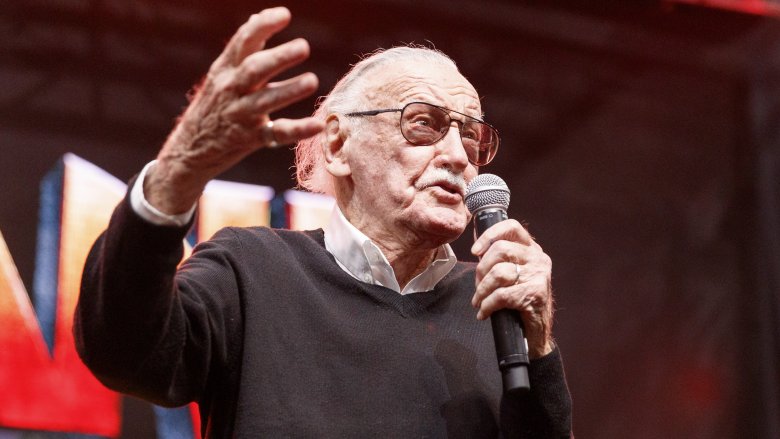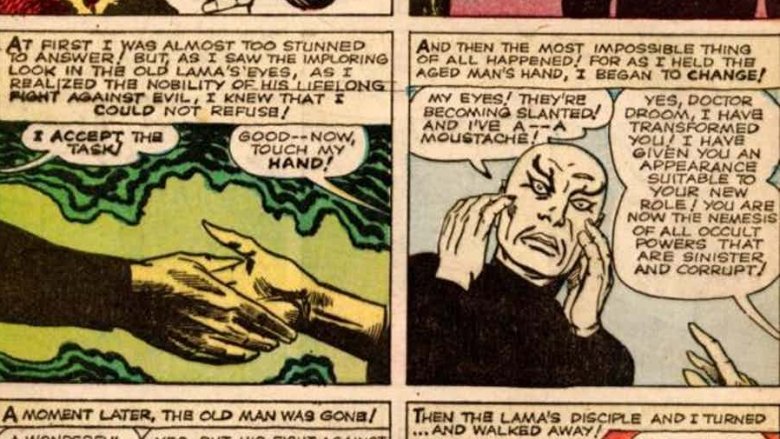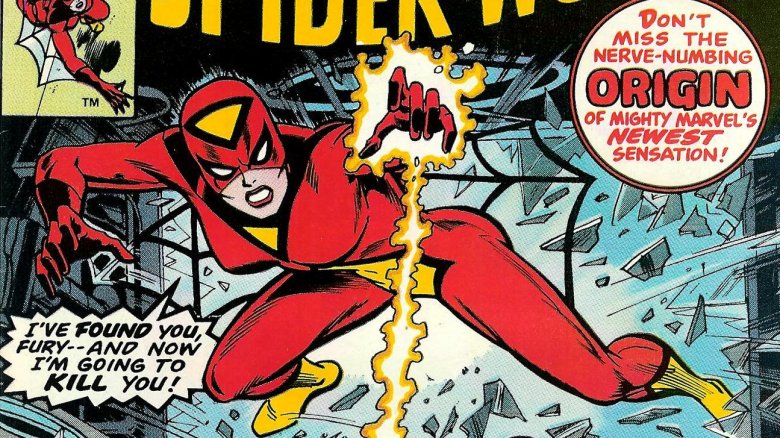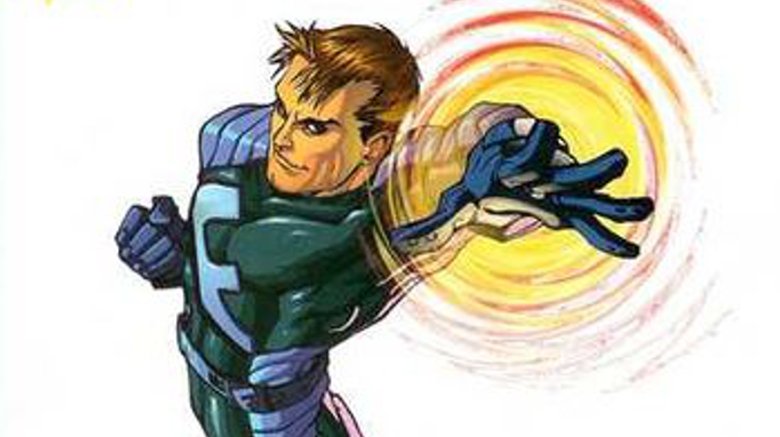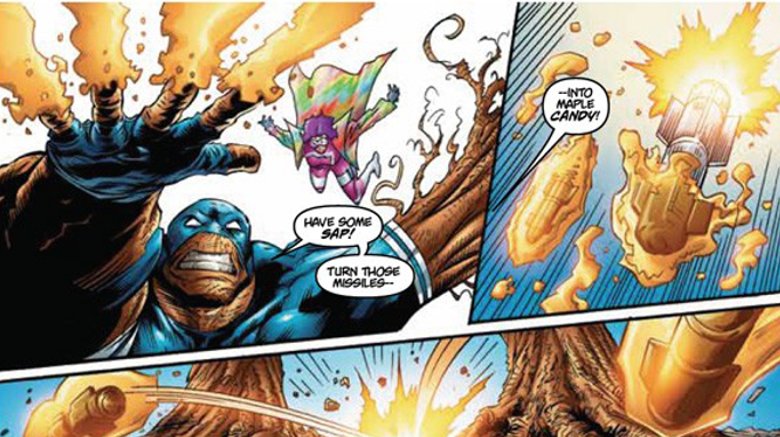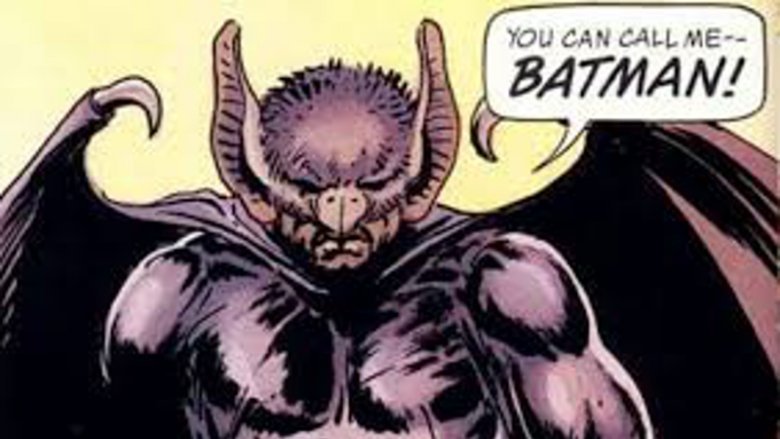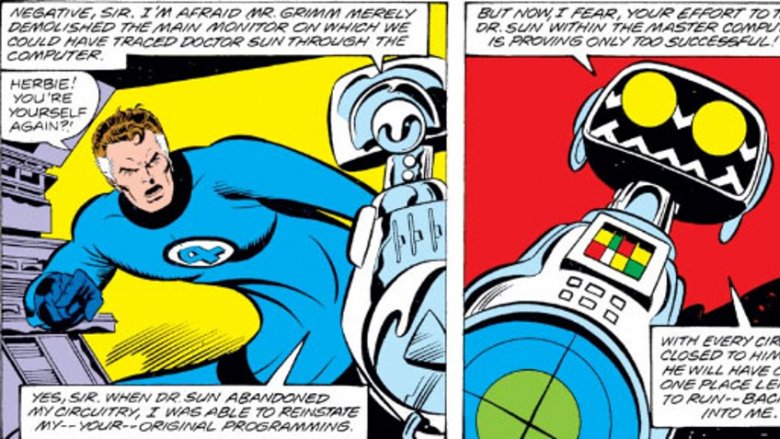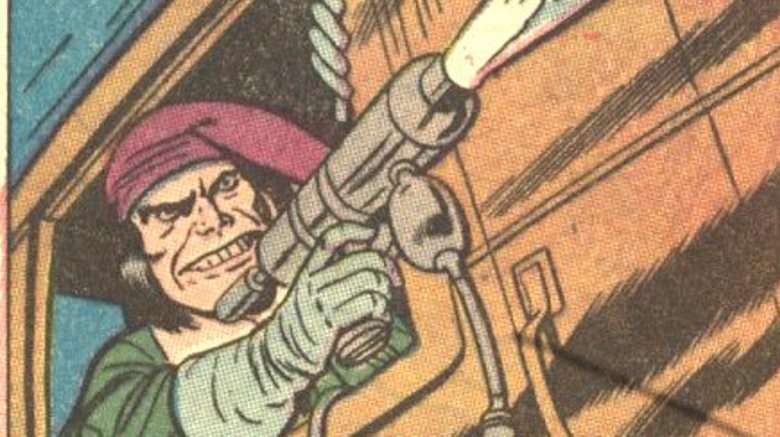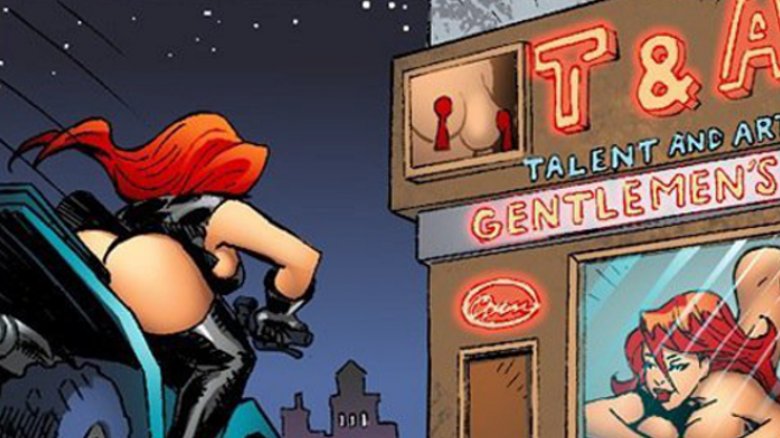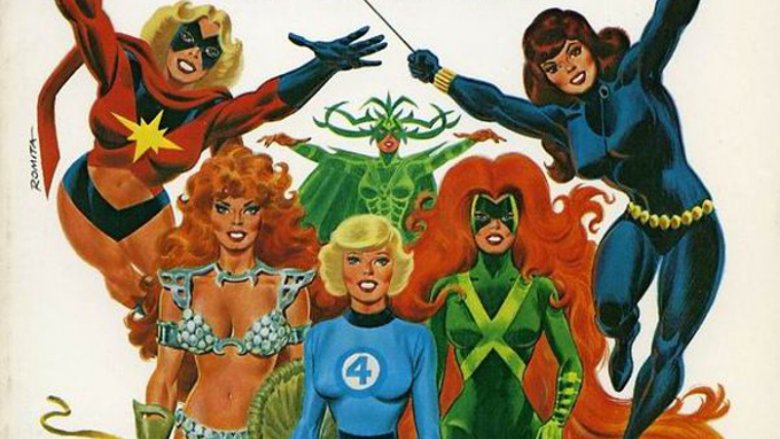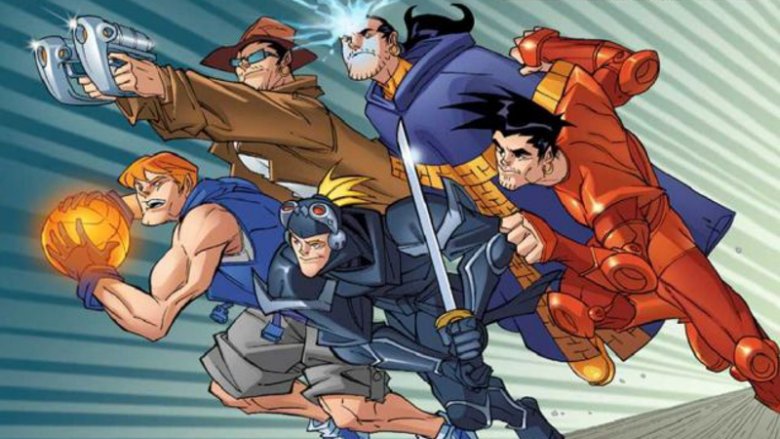Comics Stan Lee Hopes You'll Never Read
Stan Lee has never been more popular. With a franchise-connecting cameo in the latest Guardians of the Galaxy movie, and his fingerprints all over modern movies, Lee's influence is everywhere. But just because this guy created Spider-Man, Iron Man, and The Incredible Hulk, doesn't mean that he's perfect. While there's no shame in loving the nonagenarian legend, it's also sort of fun to poke around into some of his more epic misfires. Here's just a few comics we're betting Lee doesn't want to be reminded of anytime soon.
The mystical power of being Asian
"My eyes! They're becoming slanted!" With those outrageously racist words, a comic hero was born, and a new age in comics began. Yes, there was a time in comics when being Asian was considered a superpower. That time was 1961, and the team behind it is legendary. It was written by Stan Lee, penciled by Jack Kirby, and inked by Steve Ditko, three men who would go on to reshape the world of comics and popular culture. But first, they clearly had to get some bad habits out of their system.
Amazing Adventures #1 followed Dr. Droom, a wealthy American doctor fascinated by "oriental cultures" and their "mystical arts and practices," who was summoned to Tibet to help heal a sick lama. But first, as anyone who's been to Tibet can attest, he had to best a series of challenges, including walking on hot coals and facing off against a lion/gorilla hybrid. Pretty standard for the Tibetan health care system.
Proving himself worthy, the good doctor was granted access to the secrets of the orient, which gave him mystical powers. And, because the world of 1961 was a very different time, Dr. Droom gained those powers by turning Asian. Much of Droom's backstory would be repurposed a couple of years later to help setup another magical man with a love of all things oriental, Dr. Strange, but we're pretty sure even Stan Lee would admit, the strangest thing of all is how racist you could be in comics back in the day. Thankfully, they left the African-American race swapping to DC.
The unlikely origin of Spider-Woman
There are flashes of inspiration, and then there's whatever led to the original Spider-Woman. Fearful that another company could swoop in and snatch the name out from under them, Stan Lee hastily threw together a one-off issue, featuring the superbly titled superhero as a woman who'd evolved from a spider. Yeah, it was bad.
She was never meant to continue, much less find an audience, so when Marvel Spotlight #32 sold remarkably well, Lee had a bit of a problem on his hands. He had, almost willfully, put out a piece of junk for legal reasons. Now he had to figure out a way to make it good. Marv Wolfman was given the task of making her more than a title squatter. He gave her a new backstory, insisting that her memories of being born an arachnid were implanted by HYDRA, and a new name, after his daughter and the fictional detective Nancy Drew.
Jessica Drew soon developed a fan base, and an ever-evolving set of powers that never really made a lot of sense. Still, like Elizabeth Warren, she persisted, surviving cancelation and replacement. Spider-Woman has gone on to become a popular player in the Marvel Universe, with movie rumors and animated series, but we're pretty sure Stan would like to forget this character's litigious origin story.
Stan Lee hosts a game show
Stan Lee may have made his name in comics, but for the last few decades, he's really been in the Stan Lee business. Back in 2006, that meant hosting his own game show, called Who Wants to Be a Superhero? Now, you might be wondering how exactly a series like that might work, considering that superheroes aren't, you know, real. Well, thankfully it didn't involved Lee going around and killing contestants' parents in front of them, although now that we think about it, that probably would have been a better show.
No, this series saw Lee judging a ragtag collection of contestants, who each designed and dressed up as their own original superhero and then competed in challenges that were supposed to demonstrate something or another. It was never very clear. The winner was supposed to get their own movie and a comic book title created by Stan Lee himself. Sadly, considering this show had less viewers than the paint drying channel, the movie was quietly replaced with a cameo in the horror flick Mega Snake, and the comic was promptly canceled after one issue by Dark Horse, relegating the show's winner, Feedback, to the recycle bin of history.
Frankly, with a catchphrase like, "Okay, lecture's over — time for some Feedback," and an origin story that involved cellular energy, this sad attempt at a comic book shows what happens when Stan Lee just phones it in. Which didn't stop him from doing it all over again for another season. Hey, Marvel movie cameos don't pay all the bills.
NHL and Stan Lee make for awful partners
In terms of what sports fans care about, mascots' origin stories are pretty far down the list. Still, that didn't stop the NHL from wasting a bunch of money by hiring Stan Lee to flesh out their time out time killers into fully functioning superheroes, with backstories and their own comic book to boot. Dubbed The Guardians Project, this promotion would feature some of the most unoriginal superheroes this side of a Rob Liefeld comic.
While Pablo Picasso famously said, "good artists borrow, great artists steal," Lee has never been afraid to take it one step further, and steal from himself. That's how The Florida Panthers basically wound up with The Black Panther in a cape as their mascot, and The Pittsburgh Penguins got a superhero who looked exactly like The X-Men's Cyclops. Then there are the original characters, who make us think he probably should have just stuck to stealing. The absolute worst is The Maple Leaf, a tree in bike shorts who can shoot flames out of his hands, which makes no sense, because he's made of wood. Wouldn't that be sort of a fire hazard? Unsurprisingly, this promotion bombed. One tech firm said it lost them millions of dollars, thanks to how crappy it was.
Still, that didn't mean there wasn't still money to be made off of it. While the NHL and NBC Universal moved on and talk of a feature film dried up, unscrupulous businessmen decided to bury the lead, and still pitch it around as a hot property, ignoring the fact that it flopped. Filmula Entertainment took the bait and invested $500,000 in the project, eventually having to sue to get their money back. Stan Lee has always loved stories of good guys triumphing over bad, but we're guessing this is one clash he's happy he cashed out of early.
What if Batman had Spider-Man's origin story?
So how did Stan Lee write what The Nerds of Color blog called the worst Batman story ever published? DC Comics thought they'd hit the jackpot when they talked Stan Lee into swapping sides, and writing for Marvel's longtime rival. Sadly, the Stan Lee they'd signed wasn't the 1960s visionary, but the turn of the century cash grabber who would do anything for a paycheck. That's how Just Imagine Stan Lee's Batman turned into a misfire for the ages. Not because it's awful, mind you, but because it's so unoriginal.
The comic book, which was extended to 48 tedious pages, tells the story of Wayne Williams, an ex convict who takes up wrestling while seeking revenge on the gang members who killed his father. Now, if you'll recall, Stan Lee created another character whose alter identity was honed in the wrestling ring, and it wasn't Hulk Hogan. Yup, while putting his own spin on The Dark Knight, Lee just couldn't help but rip-off Spider-Man.
Lee has shown a penchant in his later years for going back to the same well over and over and over again. In a sense, it's hard to blame him, because he's responsible for so many of the archetypes we take for granted in superhero stories, but if comics like this had anyone else's name on the cover, we'd rip them apart for what they are, retreads and knockoffs. While Lee should be honored for the work he's done over the years, we're betting comics like this aren't what he wants to be remembered for.
H.E.R.B.I.E lands with a thud
When The Fantastic Four made its way to the world of Saturday morning cartoons in the late '70s, one teammate was notoriously absent. The Human Torch had disappeared, tied up in rights issues after Marvel packaged him in the deal that brought The Incredible Hulk to CBS. So how was a famous comic book creator going to fix a Fantastic Four team with only three members? If you guessed create a cloying robot sidekick to appeal to the kiddies, then you understand how the mind of Stan Lee works.
H.E.R.B.I.E, or the Humanoid Experimental Robot, B-Type, Integrated Electronics, was unpopular from, pretty much, the moment of his inception. Lee first asked X-Men artist Dave Cockrum to whip up a design for the cuddly robot, but Cockrun hated the character, and submitted one awful design after another, until Lee kicked him off the project. Jack Kirby stepped in, saving the day at the last minute.
And while H.E.R.B.I.E was a hit on the show, he's been much derided by fans over the years, especially when he made the leap from the screen, back to the comic book's pages. Stan Lee takes a lot of credit for the creation of The Fantastic Four, and rightfully so, but we're betting he doesn't bring up this lightweight character too often when he's bragging at the bar.
Lee creates world's worst villain
Few people go on runs like Stan Lee in the '60s. This guy churned out classic characters like you drop Facebook likes, all day and all night. Still, if you're making up seven superheroes a week, it isn't surprising that a few would turn out to be clunkers. That's really the only explanation for Paste-Pot Pete, a villain who used the evil power of glue to commit crime.
Yup, you read that right. Poor Pete was a lowly chemist when he accidentally created a fireproof superglue. Not wanting to let this discovery go to waste, he did what anyone in his situation would, and sold it to Elmer's for top dollar, living out his life on a tropical island. Oh, wait, no, that's what he should have done. Instead, he bought a giant, purple beret and took up a life of crime, because who can stop a man with a bucket full of superglue?
Well, if his debut in Strange Tales #104 was any indication, the answer turned out to be everybody. Apparently, in a world full of mighty men who can fly and shoot flames from their hands, the power of stickiness is not that intimidating. Lee, along with the rest of the team, quickly realized that Pete probably needed a serious revamp, and ditched the paste for high tech gadgets, and a new name, Trapster. Still, we're betting that Stan Lee will never forget the hangover he was nursing when he crapped out his worst villain ever.
Stan Lee goes from Spider-Man to strippers
Comics have taken a knock over the last few decades for not featuring enough stories about women. Somehow, we're guessing Stan Lee's Stripperella isn't what the critics had in mind. Telling the story of Exotica Jones, a stripper turned superhero that collected cash in her G-string when she wasn't fighting crime, this was a comic with severely misplaced ambitions.
Stan Lee explained he wanted to tell a story about "a girl you could empathize with," and that the world needed "a really intellectual comic strip." That somehow led to this, a collaboration with Pamela Anderson that resulted in a comic shut down before it was released and an animated series canceled after one season. And even when the world seemed to be begging for Stan to stop, he tried to keep the brand going as a webcomic that went absolutely nowhere.
Considering Lee got sued by a real stripper, who claimed she pitched the idea while giving him a lap dance, we're betting that this is one comic creation he wishes had never made it out of the Champagne Room.
Twitter kneels for no man
Even when Stan Lee tries to do something right, the blowback can be intense. For a recent International Women's Day, Stan tried to tweet out a bit of support with some classic art of female Marvel characters. The Twittersphere wasn't having it. Apparently, what comes across as progressive in 1977, has a whole other connotation today. That's why folks came out of the woodwork to highlight how all the women on the cover were buxom, white and had hourglass figures.
Fans wanted to know why he couldn't have included a more recent Marvel issue, with more diversity. Maybe Stan didn't think of it until it was too late. Maybe he just loved this old issue, which was probably TOO feminist in its day. Whatever the reason, we're guessing Lee, who has a rabid following online, probably learned to steer clear of the political after this tweet. You can't please everybody, whether it's with your superhero stories or your hashtag activism.
The Backstreet Boys are back
Never let it be said that Stan Lee doesn't love to make a quick buck. Somehow we doubt that Stan "The Man" got involved in this project, a comic book ode to all things Backstreet Boys, because he was a fan of their music. Back in 2000, Lee was brought in to create a small booklet, called The Backstreet Project, that would turn the band members into superhero stars. Less a comic than a pure promotional vehicle, it was handed out at their concerts, and used as a model for action figures that were given away in Burger King Kids' Meals.
It tells the story of the boys repelling an alien invasion in the middle of one of their concerts, using their uncanny martial arts and marksmanship skills. It was awful, and, frankly, you would think that Stan would be a wee bit ashamed that he got dragged into the boy band frenzy of the early 2000s.
But, Stan feels no shame. Not if AJ McLean is to be believed. (And any man who can pull off hoop earrings should be.) He recently told The Huffington Post, "It's funny, Nick [Carter] and I actually talked with Stan Lee not that long ago, just to brainstorm about possibly working together again somewhere down the road. So that would be pretty awesome if we get to do that again." So, want to guess what's worse than making a Backstreet Boys comic in 2000? Making one in 2017.
